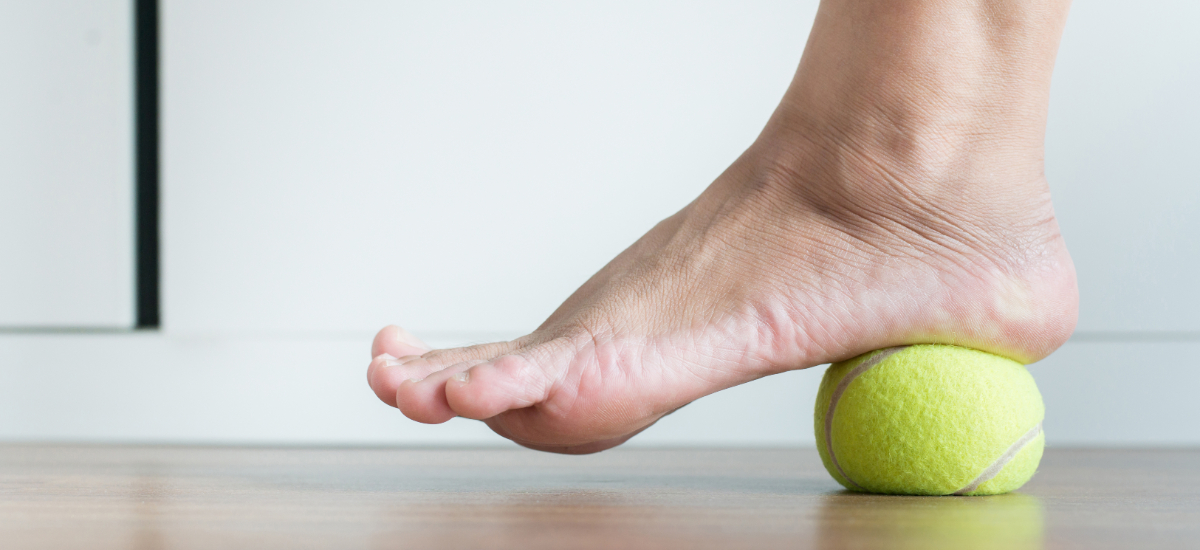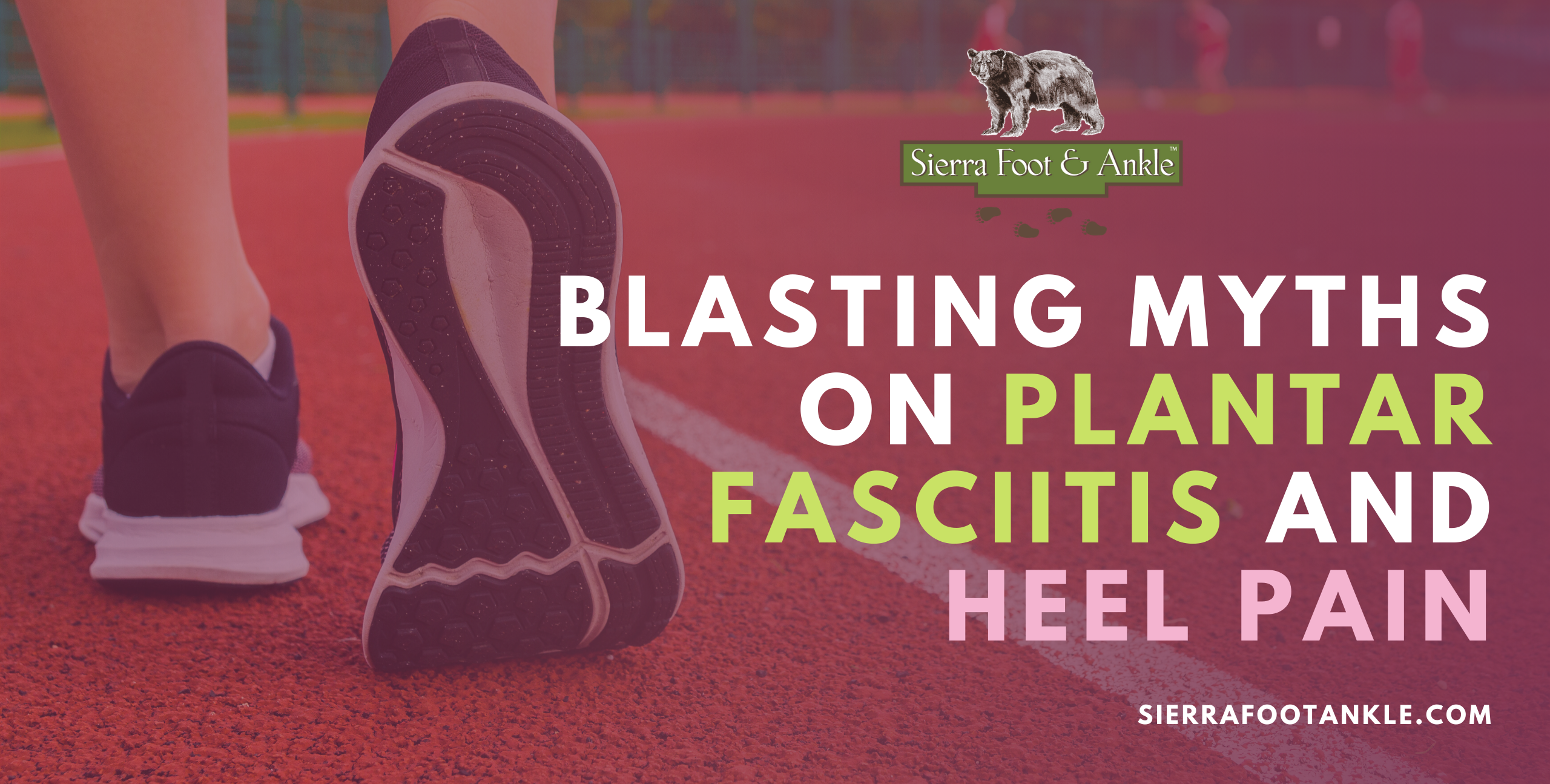Blasting Myths on Plantar Fasciitis and Heel Pain
Heel pain is a very common problem that we see, and plantar fasciitis is one of the most common diagnoses. If you are seeking help for your heel pain, don’t be surprised to hear this term come up!
But common problems are often surrounded by a swirl of myth and misinformation. Whether it relates to what plantar fasciitis is, how you get it, or what you can do about it, following bad information or advice makes for disappointing results.
Below, you’ll read about some of the myths we often hear about plantar fasciitis and heel pain in general. If you have any further questions about these conditions that aren’t addressed here, please don’t hesitate to reach out to us!
Myth: Plantar fasciitis is a “hurt foot muscle”
Not quite. While there is likely at least a little bit of tearing going on, it’s not a muscle that’s taking the strain.
The plantar fascia is a thick band of fibrous tissue—not a muscle—that connects the base of the toes to the heel bone. It runs beneath your foot and helps form your arch in the process.
Plantar fasciitis develops when the plantar fascia endures too much stress, developing tiny tears and becoming inflamed. While it is certainly possible for heel pain to be caused by an injured muscle in the foot, that is not plantar fasciitis.
Myth: Heel spurs are responsible for plantar fasciitis
This one seems to propagate because heel spurs can be found during imaging tests when looking into plantar fasciitis and other causes of heel pain.
Also, spurs are sharp, right? How could they not be causing pain!
A heel spur is a bony growth off the heel bone, and once in a while it can cause pain. The odds are higher, however, that you have a heel spur and don’t even feel it!
About 10 percent of the population has a heel spur. However, of that 10 percent, only 5 percent of them (as in, 1 in 20 people with spurs) actually feel pain caused by them.
There is heel spur-plantar fasciitis connection, however. It’s just the opposite of what you may have thought! Heel spurs are caused by your heel reacting to excess strain. That strain can be your plantar fascia pulling on the heel bone, or other forces that are contributing to your plantar fasciitis itself.
So when we see heel spurs and plantar fasciitis together, it’s much more likely that the pain is coming from the plantar fasciitis, and the heel spurs are a harmless side effect.

Myth: Plantar fasciitis is an inherited malady
If heel pain runs in your family, that doesn’t mean you are doomed to developing plantar fasciitis yourself. However, it might mean you inherited factors that can make developing plantar fasciitis (or other causes of heel pain) more likely than the average person.
Plantar fasciitis is not a genetic disease that gets handed down through generations. When it comes to foot problems, hereditary-based conditions mainly deal in structure. Bunions can be hereditary. Flat feet can be hereditary. Plantar fasciitis? Nah, not really.
That said, you may have inherited a foot structure that may increase your odds of developing plantar fasciitis. Flat feet, for an example, can place excess strain on the plantar fascia, and ultimately lead to pain.
Myth: Having plantar fasciitis must mean something else is wrong with my feet
So we’ve talked about how having a certain foot structure or condition can increase your risk of developing plantar fasciitis. However, that does not by any means imply you are immune if you have an otherwise clean bill of foot health!
Having certain risk factors can make plantar fasciitis more likely, yes. But you can also develop plantar fasciitis simply by overworking or overstraining their feet, even if there’s nothing structurally or biomechanically wrong with them.
If you push yourself beyond what your body is currently conditioned to endure, it can result in an overuse injury. Repetitive impacts of running, or simply not taking some time to warm up and ease into activity, are common triggers.
So know your limits! Listen to your body during your workouts and increase your intensity gradually week after week. That’s the best way to avoid nagging heel pain from plantar fasciitis, Achilles tendinitis, and other overuse injuries.

Myth: Plantar fasciitis can’t be cured
This is the biggest myth of all! Plantar fasciitis can, in fact, be treated effectively in nearly all cases!
What tends to trip people up, however, is that there’s no one overall remedy for the condition. But if you’ve been paying attention through the other myths, you might have an idea why this is the case.
To treat an individual case of plantar fasciitis most effectively, you must address the root causes. Is it a matter of foot structure? Is it a matter of overuse? Is it something else entirely? Once we understand these factors in your specific case, we can recommend the best course of treatment and get results.
Even if you have tried one or two types of treatment already without success, odds are good you just haven’t tried the right methods yet. We can help you determine what those are!
Call our Carson City office at (775) 783-8037 to schedule an appointment and make your heel pain vanish like Bigfoot in the mists of lore. If you prefer to contact us electronically instead, simply fill out our online contact form and a member of our staff will respond during our normal office hours.
Get In Touch
Address
2350 South Carson St
Suite 3
Carson City, NV 89701
Contact
Call: (775) 783-8037
Fax: (775) 782-3787
OPT-IN To Text:
By texting our office at
(775) 783-8037 from your mobile phone, you are consenting to receive SMS text messages from our staff. Reply STOP to unsubscribe.
*Read our Privacy Policy & Terms and Conditions.
Social




© Sierra Foot & Ankle. All Rights Reserved. Privacy Policy.
Web Design by CP Solutions. Marketed by VMD Services.

